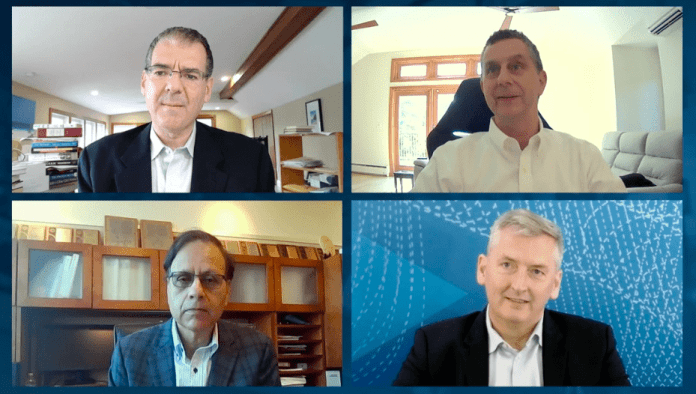“Ecosystems” for industry may be a buzzword, but that doesn’t mean there’s nothing to it, and a online panel discussion among representatives from Johnson and Johnson, Rockwell Automation and Analog Devices showed just how deeply companies are rethinking their relationships with one another and why.
The move toward Industry 4.0 is shifting the very environment in which companies compete, participants said: Manufacturers, faced with more demand for personalized products in everything from healthcare to vehicles, want more flexible production facilities and more visibility into their supply chains so that they can source appropriately and efficiently. They are looking to connect things and digitalize data in order to achieve those goals, and up and down the chain, companies are finding that they need deeper relationships with one another in order to get the level of integration and performance that they want.
“My view, is we can talk in industry terms for [Industry] 3.0, but [Industry] 4.0, we can no longer think about traditional industry structure,” said moderator Dr. Ron Adner of Dartmouth University’s Tuck School of Business. “Part of what every company on the panel is doing is trying to reconfigure their relationships with their customers, with their suppliers — we use the word “partner” a lot. … Competitiveness means not just revisiting what you’re trying to do [and] how you’re trying to do it, [but] who you’re trying to do it with and how you’re going to align that collaboration.”
After all, it would seem like a rather large leap for a chip company to be involved at a deep level with a manufacturer who uses its sensor data in operations. But Martin Cotter, SVP of industrial, consumer and multi-markets at Analog Devices, made clear that ADI has had to move to a mindset that focuses on the end use case/end impact of its products, rather than just fulfilling technical specs.
“Each of us have to learn more about the other,” said Cotter. “There was a time when we could be just fine doing something that had a bunch of technical specs and not worry too much about the end application or the end use. But in this world where we’re trying to solve a problem, things have speeded up. We each need to deliver that technology faster to that end impact, and that means that I need to make sure that [Rockwell Automation] can take what we have, and … we need to understand how ease of use and ease of adoption will speed it into a use that [J&J] might have.
“It’s not good enough anymore to be your little cog in the whole chain. You’ve got to take on that ultimate goal of addressing in value in the end use,” said Cotter.
Meanwhile, added Sujeet Chand, SVP and CTO of Rockwell Automation, companies like Rockwell are asking more and more of the sensor data that ADI’s devices provide in terms of capabilities and security, which need to be built in from the start — so that pushes a deeper relationship between the two companies as well. In addition, he said, “Most companies are connecting within their enterprise, as well as outside of their enterprise to the so-called ecosystem, whether it’s the supply chain or their machine-building partners like OEMs. So that connectivity is happening today end-to-end, and it’s complex. So we are relying on partners that simplify the complexity of end-to-end integration.”
For his part, Ken Creasy, senior director of Johnson & Johnson’s Advanced Technology Capability Centers, said that one of the biggest factors in advancing and accelerating Industry 4.0 goals is connectivity — connecting things and scaling them, and accounting for what’s coming down the pike when factories are meant to have decades-long lifecycles. Working closely with ADI, especially in the center that Creasy heads up, gives J&J the ability to test things out, and a view into technologies on the horizon that it needs to see coming.
Creasy confirmed that there is a definite push for more personalized products, all the way down to individualized medical treatments — but also, as evidenced in the pandemic, the need to be able to shift rapidly to produce, say, PPE or over-the-counter medications during waves of demand. “It’s clear that we’ll still mass-produce some things, but we need to be able to react and be more flexible,” Creasy said. And, he added, no single company is going to have every solution that J&J needs — so data standards and open-source data approaches are also becoming more important, so that companies along the supply chain can securely access the relevant data for them and J&J can maintain holistic visibility.
Large companies like J&J don’t necessarily want to integrate everything to make the solution that they need, he added, but they want to make sure that they can bring in the partners that they want. “Rockwell is not going to have every single solution that we need. Neither is Analog Devices,” Creasy said — so data and tech “needs to be accessible to the partners that we need to bring in. So then standards become very important in order to plug all these things together to make them more flexible, more modular systems.”
Chand of Rockwell Automation acknowledges this as well, that no single company has all the answers. Ecosystems, he said, are really “likeminded companies coming together to solve problems.” And many of those problems, the panelists said, are still in the early days of being addressed when it comes to Industry 4.0.
“It’s a world that we sometimes talk about what’s possible as though it’s what’s done, but it’s still something that we’re working to make this bigger future happen,” Cotter said. He later added, “The value of how we combine with others is so much bigger, and it’s solving problems that are significantly important for the whole world. It’s not just solving a particular point problem, it’s solving a problem that will transform industry.”

